New York, July 21, 2017–Authorities in the southern Mexican state of Quintana Roo must undertake a swift and credible investigation into threats against two journalists and ensure their safety, the Committee to Protect Journalists said today. On July 19, banners containing threatening messages, known as “narcomantas,” were left in two locations in Cancún, according to news reports.
Both banners carried the same message–an expletive-laden death threat and accusations that Pedro Canché, who edits a news website bearing his name, and editorial director Amir Ibrahim, of the news website El QuintanaRoo, launder money, according to news reports. The banners named a third person only by an alias. The banners were signed “Vieja Escuela Z,” the name of an organized crime group that authorities say is an offshoot of the drug trafficking cartel Los Zetas, according to news reports.
Canché told CPJ that he believes the threats came from people connected to the state’s former governors, of whom both journalists have been critical, and not criminal groups. “We have been very critical of these former governors in the past, and we’re used to getting death threats from people linked to them,” Canché said.
Violence, including against journalists, has increased in the state in recent months. Last month, CPJ documented how attackers threatened a journalist and cut off part of his ear in retaliation for his reports on the state governor.
“These threats are the latest incidents in a pattern of violence and intimidation affecting journalists in Quintana Roo,” said CPJ Senior Program Coordinator for the Americas Carlos Lauría. “State and federal authorities should act quickly to investigate these threats and ensure that Pedro Canché and Amir Ibrahim can continue to work safely.”
Both journalists have been subject to threats in the past. On July 8, Ibrahim told Article 19 he received threatening messages on his cell phone. In 2014, Canché was jailed for 271 days after state authorities accused him of organizing a protest against the rising cost of water. The verdict was discarded by a judge on May 28, 2015 and state authorities issued a public apology to the journalist in April 2017, according to news reports. CPJ determined that his imprisonment was linked to his independent reporting.
Canché told CPJ that he suspects the threats in Cancún originate from people connected to three former state governors, of whom he has been critical in his news coverage: Roberto Borge, Félix González Canto, and Mario Villanueva. Villanueva and Borge are currently imprisoned; the former in the U.S., where a federal court in New York sentenced him to 11 years in prison in 2013 for money laundering and drug trafficking, and the latter in Panama, where he was arrested after fleeing Mexico, where federal authorities accused him of graft and corruption charges. Borge, who denies all charges, is currently awaiting extradition, according to reports.
CPJ was unable to find contact information for the legal representation of the former governors.
Ricardo Sánchez Pérez del Pozo, the Federal Special Prosecutor for Attention to Crimes Committed Against Freedom of Expression, told CPJ he has requested that Canché and Ibrahim report the threats to the regional delegation of the Federal Attorney General’s office. Sánchez said that his office has sent a representative to Quintana Roo state to investigate the case.
A spokesperson of the Federal Mechanism for Protection of Journalists and Human Rights Defenders told CPJ that the mechanism is implementing protection measures for both journalists.
Mexico is one of the most dangerous countries in the world for reporters. At least four journalists have been killed there in direct relation to their work this year, according to CPJ research. CPJ is investigating a further two cases to see if the journalists’ deaths are related to their work.
